ESP AUDI A6 2014 Manual Online
[x] Cancel search | Manufacturer: AUDI, Model Year: 2014, Model line: A6, Model: AUDI A6 2014Pages: 304, PDF Size: 76.32 MB
Page 253 of 304
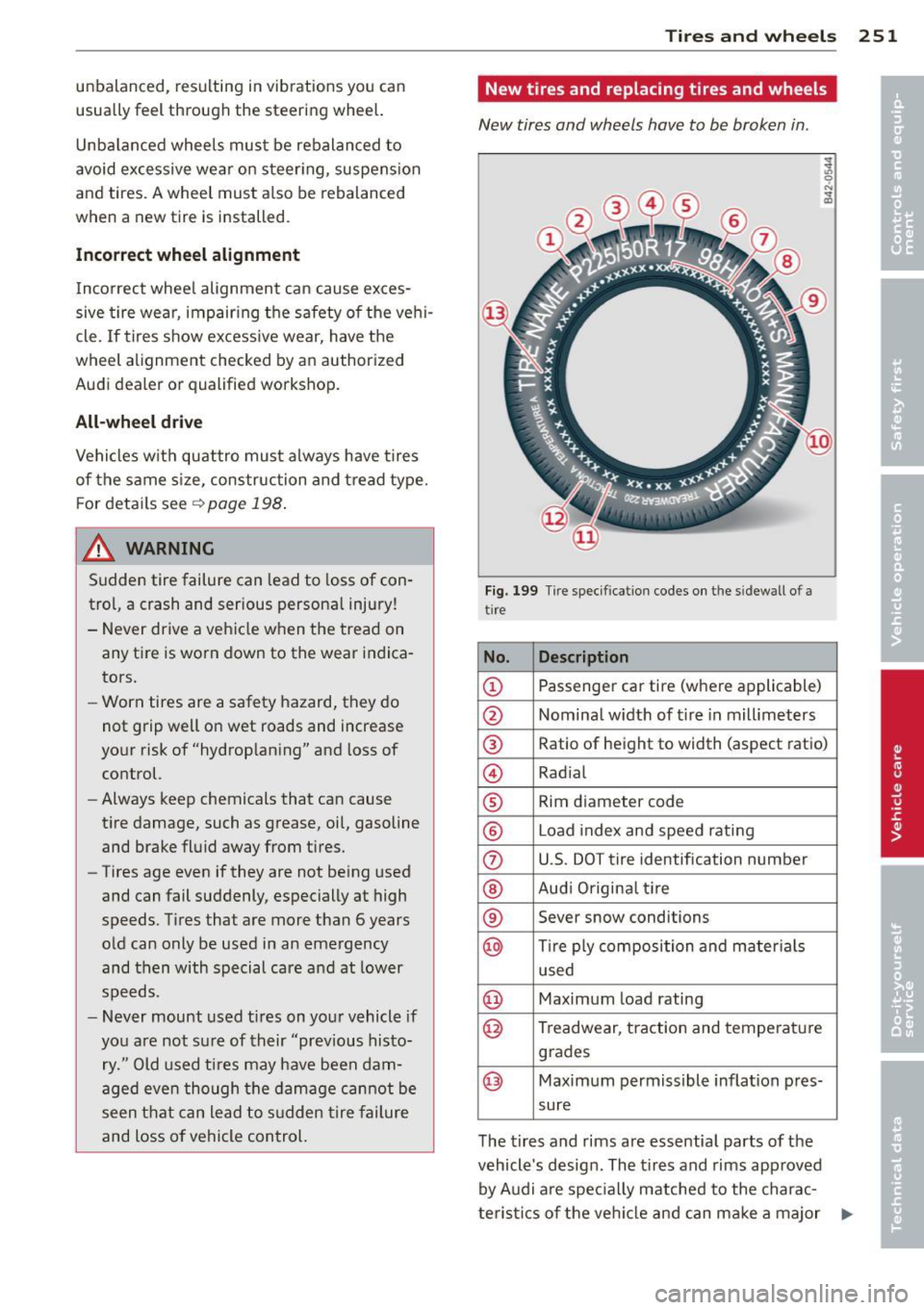
unbalanced, resulting in vib rations you can
usually feel through the steering wheel.
Unba lanced wheels mus t be rebalanced to
avoid excessive wea r on s teer ing, suspens ion
and tires. A wheel must a lso be rebalanced
when a new tire is installed.
Incorrect wheel alignment
Inco rrect whee l alignment can cause exces
sive tire wea r, impair ing t he safety of the veh i
cle. If t ires show excess ive wear, have the
wheel alignment checked by an authorized
Audi dealer or qualified workshop.
All-wheel d rive
Ve hicles w it h quattro must always have tires
of the s ame s ize, construction and tread type.
F or detai ls see
¢ page 198 .
A WARNING
Sudden tire failure can lead to loss of con
trol, a crash and serious persona l injury!
- Never drive a veh icle when the tread on
any t ire is worn down to the wear indica
tors.
- Worn tires are a safety hazard , they do
not grip well on wet roads and increase
your risk of"hydrop lan ing" and loss of
co ntrol.
- Always keep chemicals that can cause
tire damage, such as grease, oil, gasoline
and brake fluid away from tires.
- Tires age even if they are not being used
and can fail suddenly, especially at high
speeds. Tires that are more than 6 years
old can only be used in an emergency
and then with special care and at lower
sp eeds.
- Never mount used tires on yo ur vehicle if
yo u are not sure of their "previous histo
ry." Old used ti res may have been dam
aged even though the damage cannot be
seen that can lead to s udden tire failure
and loss o f vehicle control.
Tires and wheels 251
New tires and replacing tires and wheels
New tires and wheels have to be broken in.
Fig. 199 Tire spec ification codes on the s idewall of a
tire
No . Description
@ Passenger car tire (where applicable)
@ Nominal w idth of t ire in millimeters
@ Ratio of height to width (aspect ratio)
© Rad ial
® Rim diameter code
® Load index and speed rati ng
0 U.S. DOT tire identification number
® Audi Original tire
® Sever snow conditions
@ Tire ply composition and ma terials
used
@ Maximum load rating
@ Treadwear, traction and tempe rat ure
grades
@ Maximum permissible inflation pres-
sure
T he tires and rims are essential parts of the
vehicle's design . The ti res and rims approved
by Audi a re spec ia lly matched to the charac
teris tics of the ve hicl e and can m ake a major .,.
Page 255 of 304
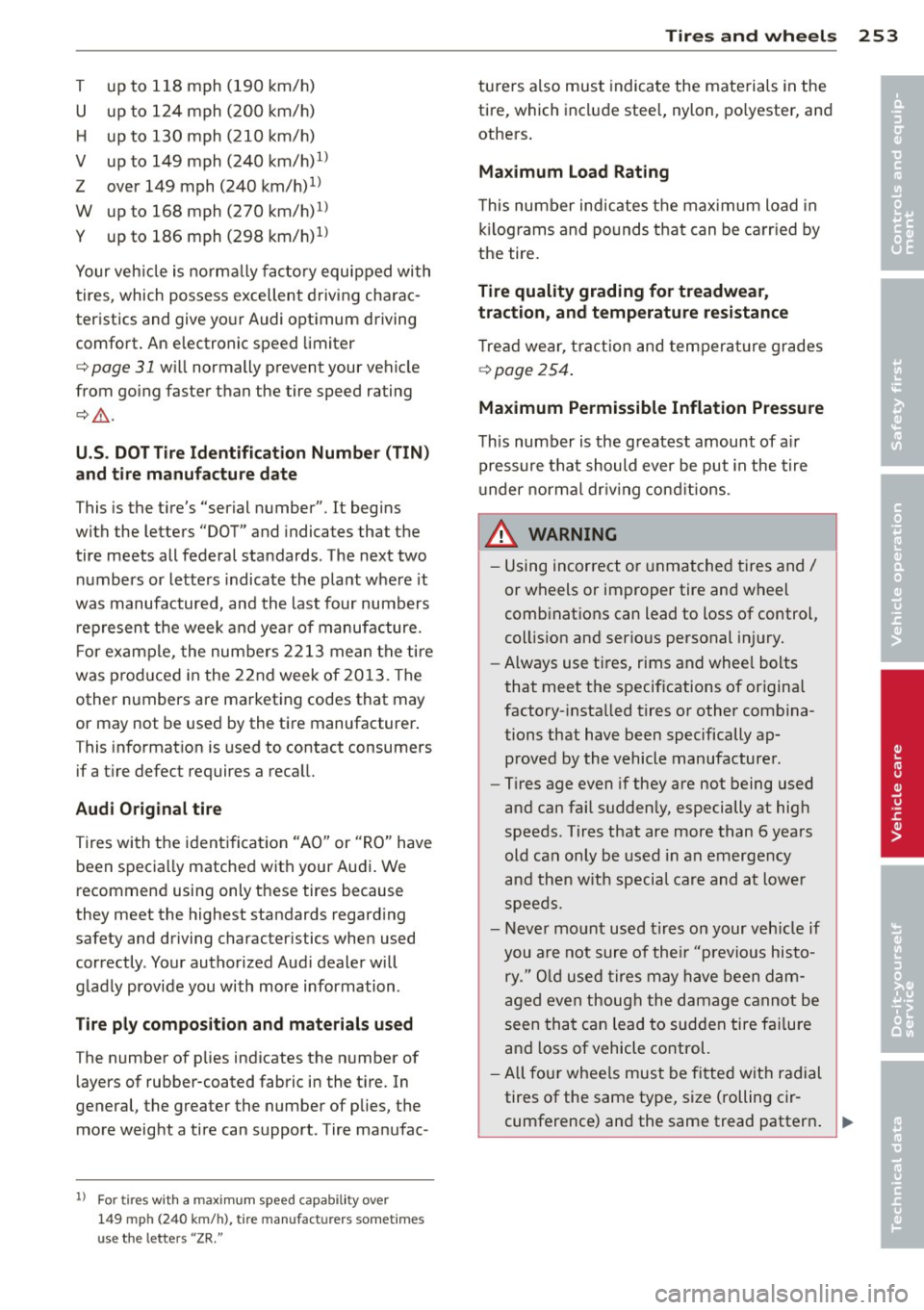
T up to 118 mph (190 km/h)
U up to 124 mph (200 km/ h)
H up to 130 mph (210 km/ h)
V up to 149 mph (240 km/h)1
)
Z over 149 mph (240 km/h)l)
W up to 168 mph (270 km/h)l)
Y up to 186 mph (298 km/h)l)
Your veh icle is no rma lly factory equipped with
tires , which possess excellent driving charac
teristics and give yo ur Audi opt imum driving
comfort . An e lectronic speed limiter
c::> page 31 w ill normally prevent you r vehicle
from go ing faster t han the tire speed ra ting
c:::> .& .
U.S . DOT T ire Id entification Numbe r (TIN )
and tire manufacture date
This is the t ire's "serial number". It begins
with the letters "DOT" and indicates that the
tire meets all federal standards . The next two
numbers or lette rs indicate the plant whe re it
was manufactured, and the last four numbers r ep resent the week and year of manufacture.
F or
examp le, the numbers 22 13 mean the ti re
was pro duced in the 2 2nd week of 2013. The
other numbers are marketing codes that may
or may not be used by the ti re manufacturer .
T his in format ion is used to contact consumers
if a t ire defect requires a reca ll.
Aud i Original tir e
Tires with t he ident ificat ion "AO" or "RO" have
been specia lly matched with your Audi . We
recommend using only these tires because
they meet the highest standards regard ing
safety and driving character istics when used
correctly . Your authorized Audi dealer will
g ladly provide you with more information .
Tire ply composit ion and materials u sed
T he number of plies ind icates the n umber of
layers of rubber-coated fabric in the t ire. In
general, the greater the number o f plies, the
more weig ht a tire can support. Tire manufac -
llFt· "h · or ires wit a m ax im um spee d ca pabil ity over
1 4 9 mp h (24 0 k m/h) , tire ma nufa ctur ers somet ime s
use th e let ters "Z R."
Tire s an d wheel s 253
ture rs also must indicate the mate rials in the
ti re, which incl ude stee l, nylon, po lyester, and
others .
Maximum Load Rating
This number ind icates the maximum load in
k ilograms and po unds that can be ca rr ied by
the tire.
Tire quality grading for treadwear,
traction, and temperature resistance
T re ad wear, t raction and tempera ture grades
c::> page 2 54 .
Maximum Permissible Inflation Pressure
This number is the greatest amount of a ir
pressure tha t should ever be pu t in the t ire
u nder norma l dr iv ing cond itions .
_&. WARNING ,-=
-Using incorrect o r unmatched tires and/
or wheels or improper tire and wheel
comb inatio ns can lead to loss of control
'
coll is ion and serious personal inj ury.
- Always use ti res, rims and whee l bolts
that meet the specifications of original
factory- insta lled tires or other combina
tions that have been specifically ap proved by the vehicle manufacturer.
- Tires age even if they are not being used
a nd can fai l sudden ly , especially at hig h
speeds . Tires that are more than 6 years
old can only be used in an emergency
a nd then w ith specia l care and at lower
speeds.
- Never mo unt used tires on your veh icle if
you are not sure of the ir "previous histo
ry." O ld used tires may have been dam
aged even though the damage cannot be
seen that can lead to sudden tire fai lure
and loss of vehicle control.
- All fou r whee ls must be fitte d wit h radial
tires of the same type, size (rolling cir
cumference) an d the same tread pattern .
~
•
•
Page 257 of 304
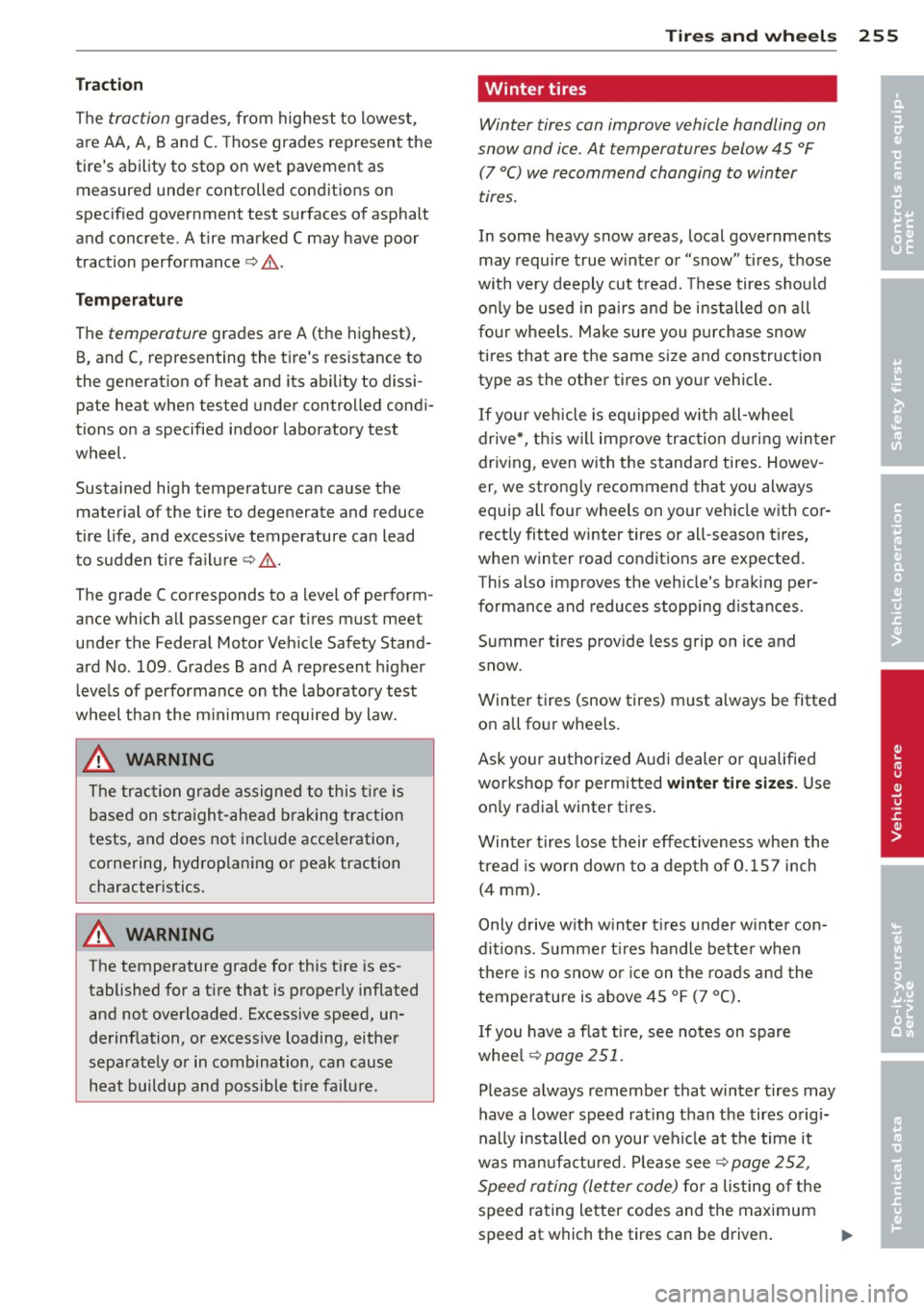
Traction
The traction grades, from highest to lowest,
a re AA, A, Band
C. Those grades represent the
tire's ability to stop on wet pavement as
measured under controlled conditions on
specified government test surfaces of asphalt
and concrete . A tire marked C may have poor
traction performance¢ .&..
Temp eratu re
The temperature grades are A (the highest),
B, and
C, representing the tire 's resistance to
the generat ion of heat and its ability to dissi
pate heat when tested under controlled condi
tions on a specified indoor laboratory test
wheel.
Sustained high temperature can cause the
material of the tire to degenerate and reduce
tire life, and excessive temperature can lead
to sudden tire failu re ¢ .&. .
The grade C corresponds to a level of perform
ance which all passenger car tires m ust meet
u nder the Federa l Motor Ve hicle Safety Stand
ard No.
1 09. Grades Band A represent higher
l eve ls of pe rformance on the laboratory test
wheel than the m inimum required by law.
_& WARNING
Th e traction grade assigned to this tire is
based on stra ight-ahead b raking t raction
tests, and does not include acceleration,
cornering , hydrop laning or peak traction
character istics.
A WARNING
The temperature grade for this t ire is es
tablished for a t ire that is properly inflated
and not overloaded. Excessive speed, un
derinflation, or excessive loading, either
separate ly or in combination, can cause
heat buildup and possibl e tire fa ilu re.
-
Tire s an d wheel s 255
Winter tires
Winter tires can improve vehicle handling on
snow and ice . At temperatures below 45 °F
(7 °C) we recommend changing to winter
tires.
In some heavy snow areas, local governments
may require true w inter o r "snow" tir es, those
with very deeply cut t read. These tires should
o nl y be used in pairs and be installed o n all
f o ur wheels . Make sure you p urchase snow
ti res that are the same size and cons truc tion
type as the other tires on yo ur vehicle .
I f your veh icle is eq uipped w ith all-whee l
drive *, t his w ill improve trac tion durin g w in ter
driv ing, even wi th the s tanda rd tires. Howev
er, we strongly recommend that you always
equip all four wheels on your veh icle w ith cor
rect ly fitted winter tires or all-season t ires,
when winter road condit ions are expected.
This also improves the veh icle 's b rak ing per
fo rmance and reduces stoppi ng d ista nces .
Summer tires provide less grip on ice and
snow.
Winter tires (snow tires) must always be fitted
o n all fo ur whee ls .
As k your au thori zed A udi d ealer or qualified
workshop for permit ted
winter tire size s. Use
o nl y radial winter ti res .
Win ter tires lose their effec tiveness whe n the
tread is worn down to a depth o f
0.15 7 inch
(4 mm) .
Only d rive w it h w inte r tir es under w inte r con
di tions. S umme r tir es handle bette r whe n
t h e re is no s now o r ice on the ro ad s an d the
temperature is above 45 ° F (7 °C) .
I f you have a flat t ire, see notes on spare
whee l
¢page 25 1.
Please a lways remember that winter tires may
have a lowe r sp eed rating than the tires o rig i
nally i nstalled on your veh icle at t he time it
was ma nufactu red. Please see ¢
page 2 52,
Speed ra ting (letter code)
for a lis ting o f th e
speed ra ting lette r codes and the max imum
speed at which the tires can be driven .
111>-
•
•
Page 260 of 304
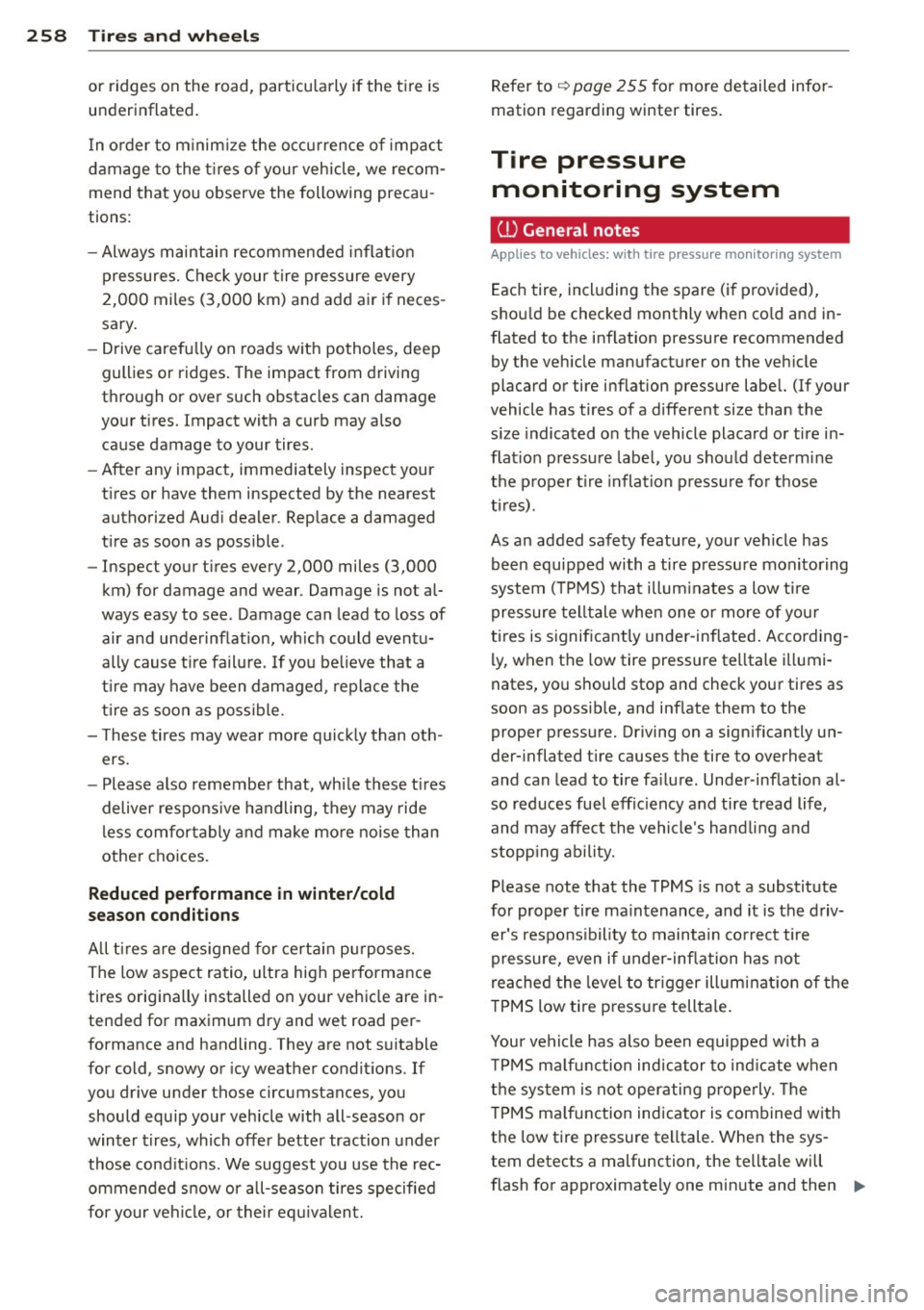
258 Tires and wheels
or ridges on the road, particularly if the tire is
underinflated.
I n o rder to minim ize the occurrence of impact
damage to the tires of your vehicle, we recom
mend that you observe the following precau
tions:
- Always maintain recommended inflation
pressures. Check your tire pressure every
2,000 miles (3,000
km) and add air if neces
sary .
- Drive carefu lly on roads with potholes, deep
gullies or ridges. The impact from driving
through or over such obstacles can damage
your tires. Impact with a curb may also cause damage to your tires.
- After any impact, immediately inspect your
tires or have them inspected by the nearest
authorized Aud i dealer. Replace a damaged
t ir e as soon as possible .
- Inspect your tires every 2,000 miles (3,000
km) for damage and wear . Damage is not al
ways easy to see . Damage can lead to loss of
air and underinflation, wh ich could eventu
ally cause t ire failure . If you be lieve that a
t ir e may have been damaged, replace the
tire as soon as possible.
- T hese tires may wea r mo re quick ly than oth
ers.
- Please a lso remember that, while these t ires
deliver respons ive handling, they may ride
less comfortably and make more no ise than
other choices.
Reduced performance in winter/cold
season conditions
All tires are designed for certain purposes.
The low aspect ratio, ultra high performance
tires originally installed on your vehicle are in
tended for maximum dry and wet road per
formance and handling. They are not suitable
for cold, snowy or icy weather condit ions. If
you drive under those circumstances, you should equip your vehicle with all -season or
winter tires, which offer better traction under
those cond it ions. We suggest you use the rec
ommended snow or all-season tires specified
for your vehicle, or their equivalent. Refer
to
q page 255 for more detailed infor
mation regarding winter tires.
Tire pressure monitoring system
ill General notes
Applies to veh icles: w ith tire pressure monitoring system
Each tire, including the spare ( if provided),
shou ld be checked monthly when co ld and in
flated to the inflation pressure recommended
by the veh icle manufacturer on the vehicle
placard or tire inflation pressure label. (If your
vehicle has tires of a different size than the
s ize indicated on the vehicle placard or tire in
flation pressure label, you should determine
the proper tire inflation p ressu re fo r those
t i res).
As an added safety feature, your ve hicle has
been equipped with a tire pressure mon itoring
system ( TPMS) that illuminates a low tire
pressure telltale when one or more of your
tires is significant ly under-inflated. According
l y, when the low tire pressure telltale i llumi
nates, you should stop and check your tires as
soon as possible, and inflate them to the
proper pressure. Driving on a sign ificantly un
der-inflated t ire causes the tire to overheat
and can lead to tire fa ilure . Under-inflation al
so reduces fuel efficiency and tire tread life,
and may affect the vehicle 's handling and
stopping ability.
Please note that the TPMS is not a substitute
for proper tire ma intenance, and it is the driv
er's responsibility to maintain correct tire
pressure, even if under-inflation has not
reached the level to trigger illuminat ion of the
TPMS low tire pressu re tellta le .
Your vehicle has also been equipped with a
TPM S malfunction indicator to ind icat e when
the system is not operating properly. The
T PMS ma lfunction indicator is combined with
the low tire pressure telltale. When the sys
tem detects a malfunction, the telltale will
flash for approximately one minute and then ..,_
Page 262 of 304
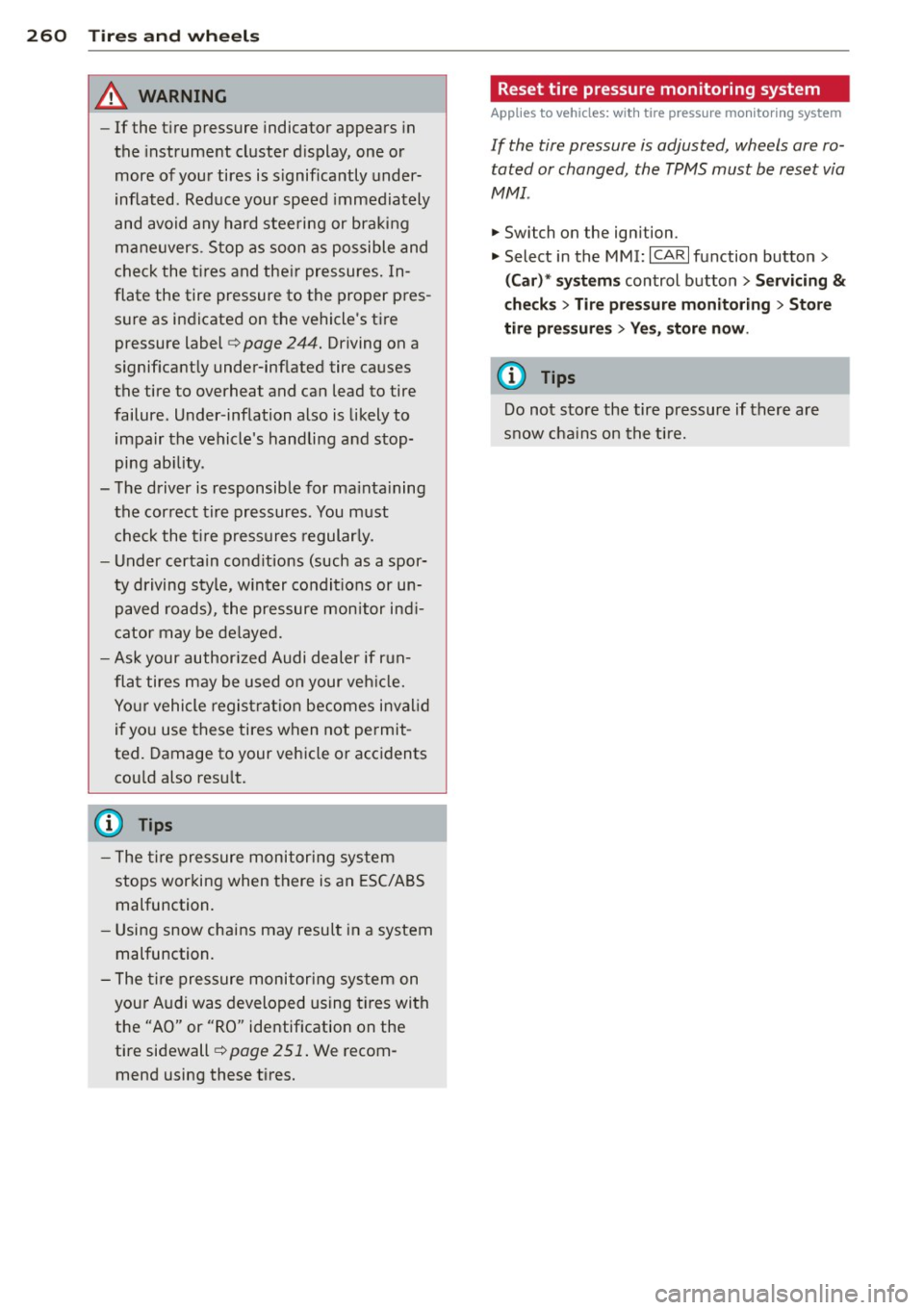
260 Tire s and wheel s
_&. WARNING
-If th e tire pressure indicator appea rs in
the instrument cluster d isplay, one or
more of your tires is s ignificantly under
inflated. Reduce your speed immediately
and avoid any hard stee ring or bra king
maneuvers . Stop as soon as possible and
check the t ires and the ir pressures. In
flate the tire pressure to the proper pres
sure as indicated on the vehicle 's t ire
pressure label
c> page 244. Driving on a
signif icant ly under-inflated tire causes
the tire to overheat and can lead to tire
failure. Under-inflation also is likely to impair the vehicle 's handling and stop
ping ab ility .
- The driver is responsible for ma inta ining
the correct tire pressures. You must che ck the t ire pressures regula rly.
- Under certain cond itions (such as a spor
ty driving style, winter condit ions or un
paved roads), the pressure mon itor ind i
c ator may be de layed.
- Ask your author ized Audi dealer if r un
flat tires may be used on your veh icle.
Yo ur vehicle regist rat ion becomes inval id
if yo u use these tires when not permit
ted . Damage to your vehicle or acc idents
cou ld also resu lt.
(D Tips
- The tire pressure monitoring system
stops working when there is an ESC/ABS
malfunction.
- Using snow chains may result in a system
malfunction.
- The tire pressure monitoring system on
you r A udi was develope d using t ires with
the "AO" or "RO" identification on the
tire sidewall ~
page 251 . We recom
mend using these t ires.
Reset tire pressure monitoring system
Applies to vehicles: with tire pressure monitoring system
If the tire pressure is adjusted, wheels are ro
tated or changed, the TPMS must be reset via
MMI .
.. Switch on the ignition.
.. Select in the MMI :
ICARI function button>
(Car)* system s control button > Servicing &
checks > Tire pres sure monitoring > Store
tire pre ssur es > Ye s, store now .
@ Tips
Do not sto re the tire pressure if there are
s now cha ins on the tire.
Page 275 of 304
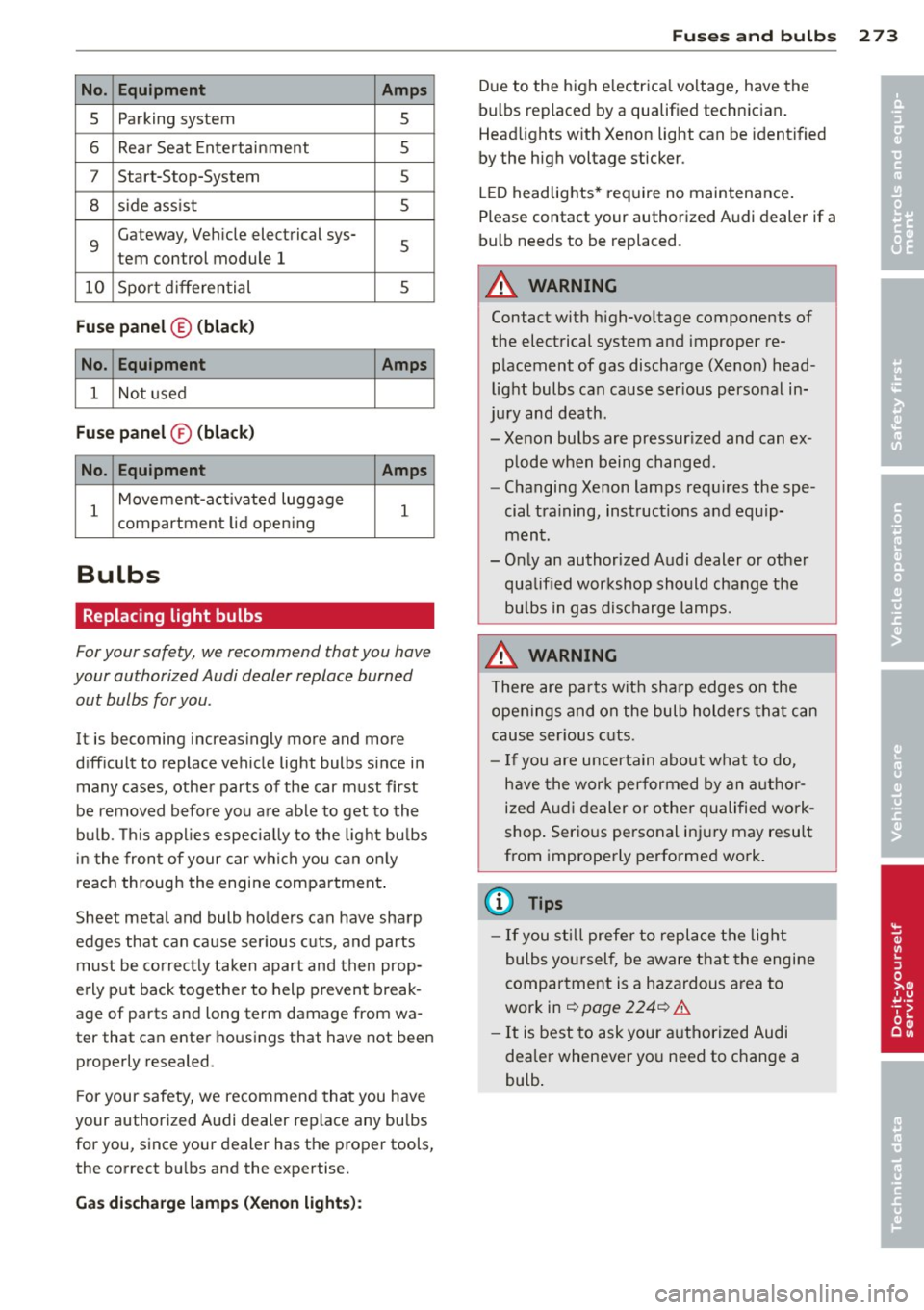
No. Equipment Amps
5 Parking system 5
6 Rear Seat Entertainment 5
7 Start-Stop-System 5
8 side ass ist 5
9
Gateway, Vehicle electrical sys-
5 tern control module 1
10 Sport differential
5
Fuse panel © (black)
No. Equipment
Amps
1 Not used
Fuse panel ® (black)
No. Equipment
Amps
1 Movement-activated luggage 1
compartment lid opening
Bulbs
Replacing light bulbs
For your safety, we recommend that you have
your authorized Audi dealer replace burned
out bulbs for you.
It is becoming increasingly more and more
difficult to replace vehicle light bulbs since in
many cases, other parts of the car must first
be removed before you are able to get to the
bulb. This appl ies especially to the light bulbs
in the front of your car which you can only
reach through the engine compartment .
Sheet metal and bulb ho lders can have sharp
edges that can cause ser ious cuts, and parts
must be correctly taken apart and then prop
erly put back together to help prevent break
age of parts and long term damage from wa
ter that can enter housings that have not been properly resealed.
F or your safety, we recommend that you have
your authorized Audi dealer replace any bulbs for you, since your dealer has the proper tools,
the correct bu lbs and the expertise .
Gas discharge lamps (Xenon lights):
Fuses and bulbs
Due to the high e lectr ica l voltage, have the
bulbs replaced by a qualified technician.
Head lights w ith Xenon light can be identified
by the high voltage sticker.
LED headlights* require no maintenance.
Please contact your authorized Audi dealer if a
bulb needs to be replaced.
_& WARNING
Contact with high-voltage components of
the electrical system and improper re
placement of gas discharge (Xenon) head
light bulbs can cause ser ious personal in
jury and death .
- Xenon bulbs are pressur ized and can ex
plode when being changed .
- Changing Xenon lamps requ ires the spe
cial tra ining, instructions and equip
ment.
- Only an authorized Audi dealer or other
qualified workshop should change the
bulbs in gas discharge lamps.
&_ WARNING
There are parts with sharp edges on the
openings and on the bulb holders that can
cause serious cuts.
- If you are uncertain about what to do,
have the work performed by an author
ized Audi dealer or other qualified work
shop . Serious personal injury may result
from improperly performed work.
(D Tips
-If you still prefer to replace the light
bulbs yourself, be aware that the engine
compartment is a hazardous area to
work in ¢
page 224¢ &.
-It is best to ask your authorized Audi
dealer whenever yo u need to change a
bulb .
273
•
•
Page 281 of 304
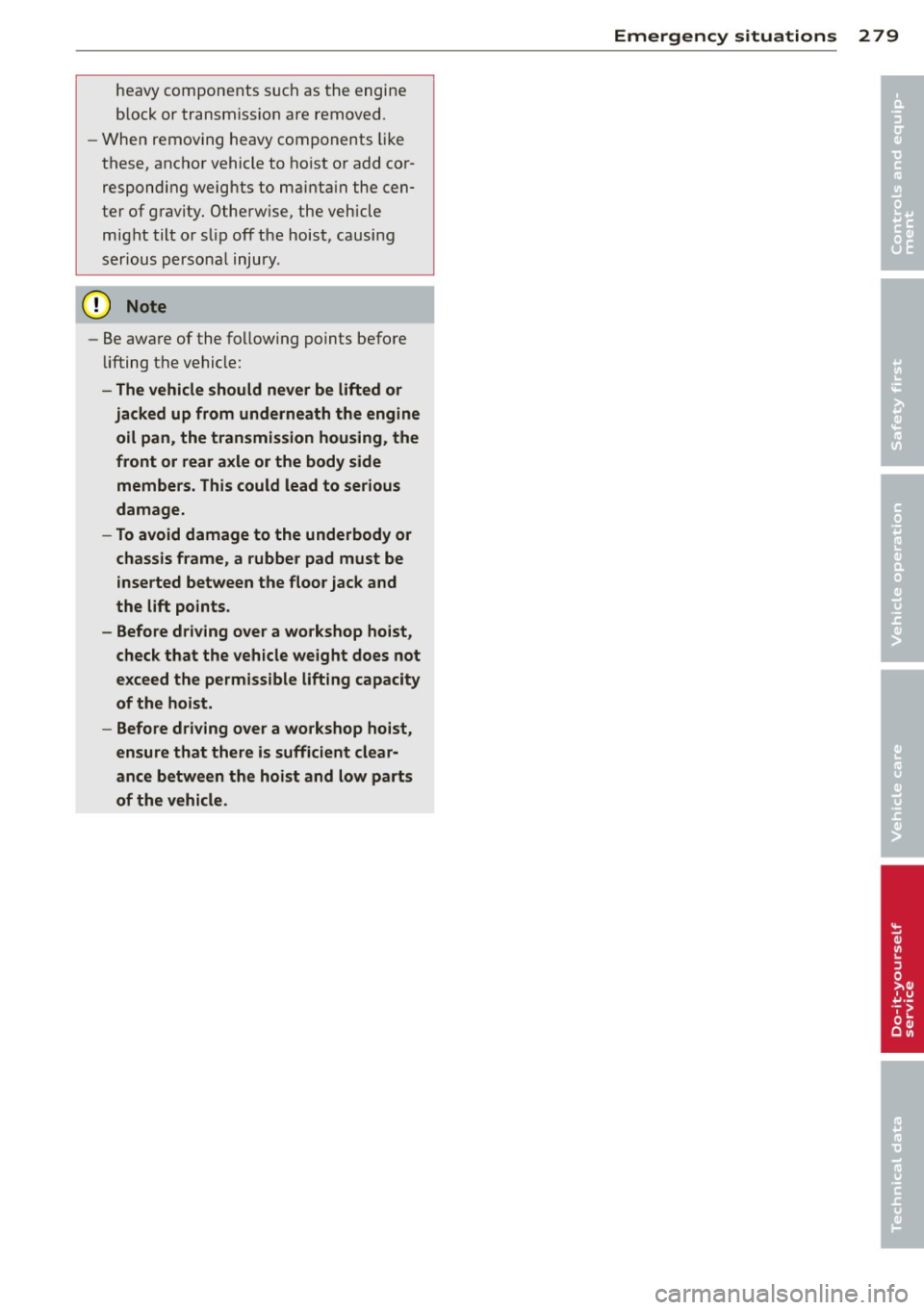
heavy components such as the engi ne
b lock or transmiss ion are removed.
- W hen removing heavy components like
these, ancho r vehicle to hoist o r add cor
respond ing weig hts to ma inta in the cen
ter of g ravity . Otherwise, the vehicle
m ight tilt o r sli p off the hoist, causi ng
ser ious p erso na l in ju ry.
([) Note
-Be awa re of the fo llowing points befo re
li fting t he vehicle:
- The vehicle should never be lifted or
jacked up from underneath the engine oil pan, the transmission housing, the
front or rear axle or the body side
members. This could lead to serious
damage.
- To avoid damage to the underbody or
chassis frame , a rubber pad must be
i nserted between the floor jack and
the lift points.
- Before driving over a workshop hoist,
check that the veh icle weight does not
exceed the permissible lifting capacity
of the hoist.
- Before driving over a workshop hoist,
ensure that there is sufficient clear
ance between the hoist and low parts
of the vehicle.
Emergency situations 2 79
•
•
Page 285 of 304
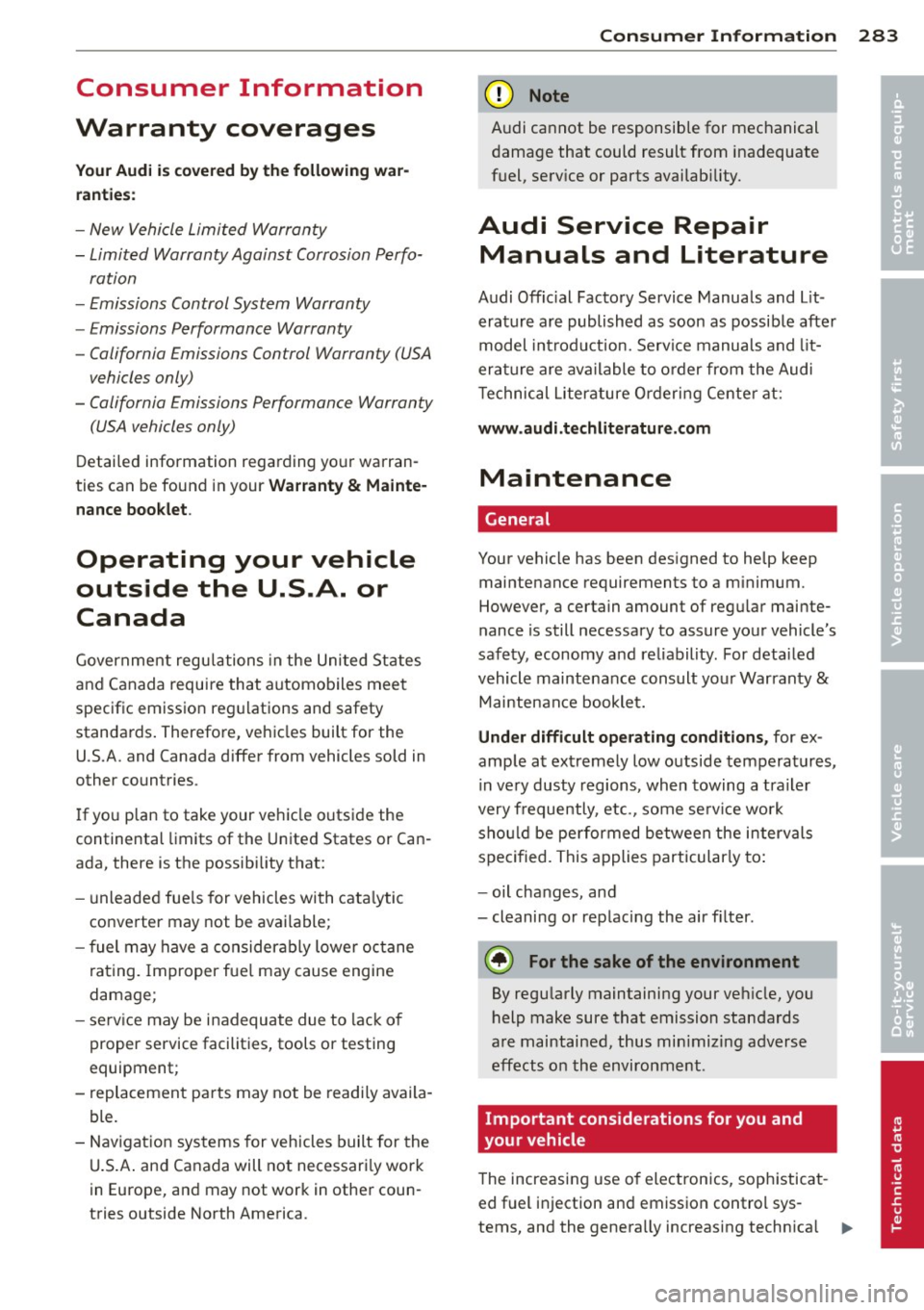
Consumer Information
Warranty coverages
Your Audi is covered by the following war
ranties :
- New Vehicle Limited Warranty
- Limited Warranty Against Corrosion Perfo-
ration
- Emissions Control System Warranty
- Emissions Performance Warranty
- California Emissions Control Warranty (USA
vehicles only)
- California Emissions Performance Warranty
(USA vehicles only)
Detailed information regarding yo ur warran
ties can be found in your
Warranty & Mainte
nance booklet .
Operating your vehicle
outside the U.S.A. or
Canada
Government regulations in the United States
and Canada require that automobiles meet
specific emission regulations and safety
standards. Therefore, veh icles built for the
U.S.A. and Canada differ from vehicles sold in
other countries .
I f you p lan to take your vehicle outside the
continental limits of the United States or Can
ada, there is the possibility that:
- unleaded fuels for vehicles with cata lytic
converter may not be available;
- fuel may have a considerably lower octane
rating . Improper fuel may cause engine
damage;
- service may be inadequate due to lack of
proper service facilities, tools or testing
equipment;
- replacement parts may not be readily availa
ble.
- Navigation systems for vehicles built for the
U.S.A. and Canada will not necessari ly work
in Europe, and may not work in other coun
tries outside North America .
Consumer Information 283
@ Note
Audi cannot be responsible for mechanical
damage that could result from inadequate
fuel, serv ice or parts availab ility.
Audi Service Repair
Manuals and Literature
Audi Offic ial Factory Service Manuals and Lit
erature are published as soon as possible after
model introduct ion. Service manuals and lit
erat ure are available to order from the Audi
T echnical Literature Ordering Center at:
www.audi.techliterature.com
Maintenance
' General
Your vehicle has been designed to help keep
maintenance requirements to a m inimum.
However, a certain amount of regular mainte
nance is still necessary to assure your vehicle's
safety, economy and reliability . For detailed
vehicle maintenance consult your Warranty
&
Maintenance booklet.
Under difficult operating conditions , for ex
ample at extremely low outside temperatures,
in very dusty regions, when towing a trailer
very frequently, etc., some serv ice work
shou ld be pe rformed between the intervals
specified. This applies particularly to:
- oil changes, and
- cleaning or replacing the air filter.
® For the sake of the environment
By regularly maintaining your veh icle, you
help make sure that emission standards
are maintained, thus min imiz ing adverse
effects on the environment .
Important considerations for you and
your vehicle
The increasing use of electronics, sophistica t
ed fuel injection and emission contro l sys-
tems, and the genera lly increasing technica l ..,_
•
•
Page 288 of 304
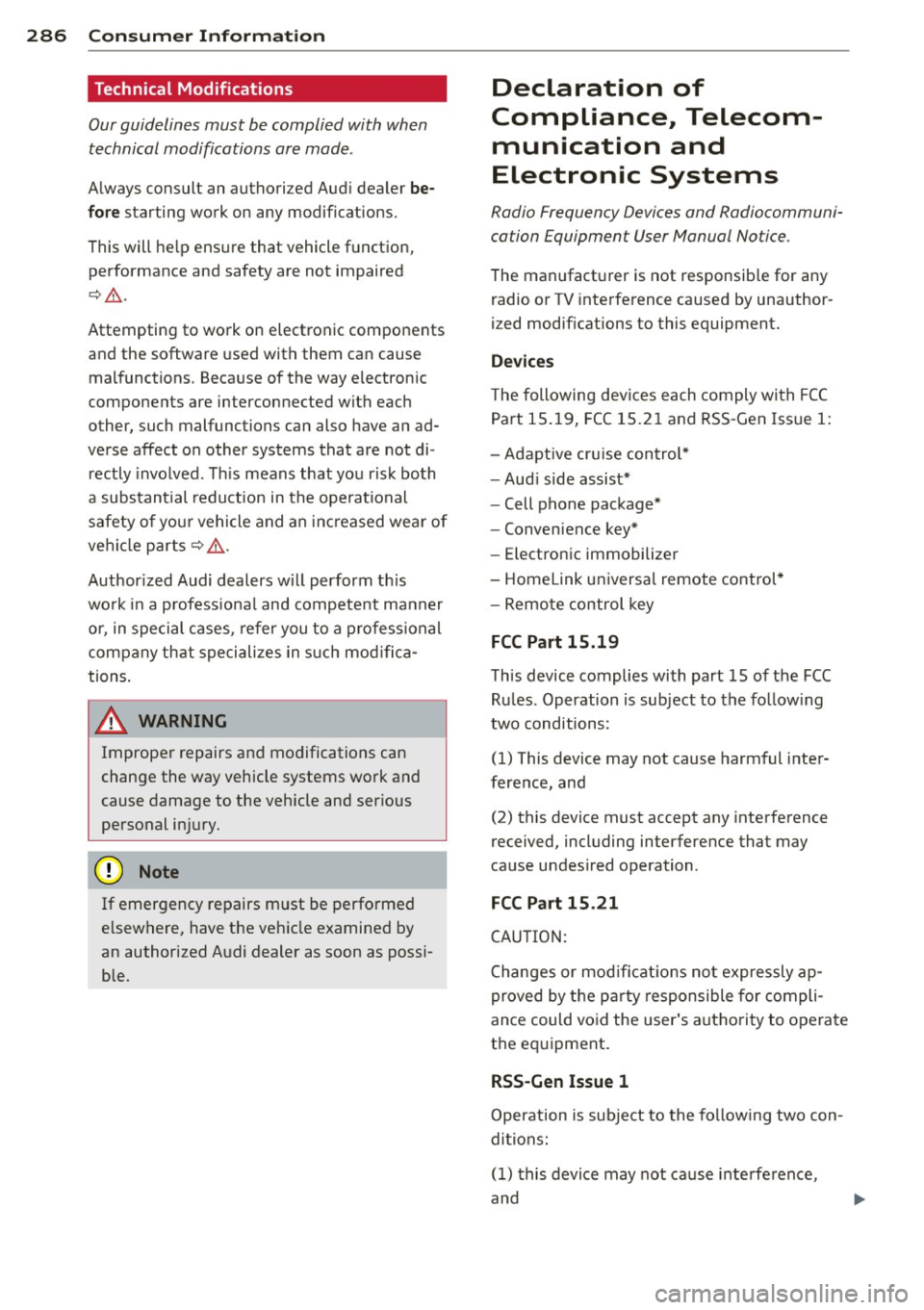
286 Consumer Information
Technical Modifications
Our guidelines must be complied with when technical modifications are made .
Always consult an authorized Audi dealer be
fore starting work on any modifications.
This will help ensure that vehicle function,
performance and safety are not impaired
¢ &. .
Attempting to work on electronic components
and the software used with them can cause
malfunctions. Because of the way electronic
components are interconnected with each
other, such malfunctions can also have an ad
verse affect on other systems that are not di
rectly involved. This means that you risk both
a substantial reduction in the operational
safety of your vehicle and an increased wear of
ve hicle parts ¢
A:,..
Author ized Audi dealers will perform th is
wo rk in a professiona l and competent manner
or, in special cases, refer you to a professional
company that specializes in such modifica
tions .
A WARNING
Improper repairs and modifications can
change the way vehicle systems work and
cause damage to the vehicle and serious
personal injury.
-
If emergency repairs must be performed
elsewhere, have the vehicle examined by
an authorized Audi dealer as soon as possi
ble.
Declaration of
Compliance, Telecom
munication and
Electronic Systems
Radio Frequency Devices and Radiocommuni
cation Equipment User Manual Notice.
The manufacturer is not responsib le for any
radio or TV interference caused by unauthor
ized modifications to this equipment.
Devices
T he following devices each comply with FCC
Part 15.19, FCC 15.21 and RSS-Gen Issue 1:
- Adapt ive cru ise control*
- Aud i side assist*
- Cell phone package*
- Convenience key*
- Electron ic immobilizer
- Homelink universa l remote control*
- Remo te control key
FCC Part 15.19
This device complies with part 15 of the FCC
Ru les. Operation is subject to the follow ing
two conditions:
(1) This device may not cause harmful inter
ference, and
(2) this device must accept any interference
received, including interference that may
cause undesired operation .
FCC Part 15.21
CAUTION:
Changes or modificat ions not expressly ap
proved by the party responsible for compli
ance could void the user's authority to operate
the equipment .
RSS-Gen Issue 1
Operation is subject to the following two con
ditions:
(1) this device may not cause interference ,
and